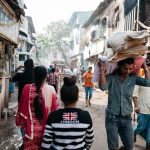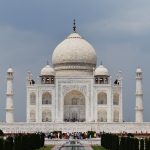Among the first of many realizations you’ll have when you arrive in India is that there is no such thing as “Indian food.” The Indian subcontinent packs in as much or more diversity than Europe and the food is no exception. To help you get your bearings, we’ve created a guide of our “must-try” foods in Northern India. (PS: You should also come on our Old Delhi street food tour and we’ll show you the best places to sample these dishes!)
Chole Bhature – छोले भटूरे
The quintessential Delhi street food, Chole Bhature is spicy chickpeas eaten with fried bread (bhature). Typically sold at street stalls or small restaurants, it can be a great snack or meal at any time of day. It can be easily identified by the puffed up bhature.
As with any street food, be sure to evaluate the cleanliness of the stall before ordering. Checking how busy the stand is and how they handle the money (ideally someone who isn’t handling the food!) are both good indicators.
Thali – थाली
Thali is the sampler plate of India. This is the easy choice for the indecisive or those that want to try a bit of everything. While it’s different everywhere, you can expect to get several different curries, salad, and a sweet dish or two. It’s eaten with either roti or chapatti. At the end they will typically bring rice, so be sure to pace yourself!
Rajma Chawal – राजमा चावल
Rajman Chawal is a tasty kidney bean curry served with steamed rice. The kidney bean isn’t native to India, but it’s now a staple of the North Indian diet. It grows very well in the far north states like Himanchal Pradesh and Jammu.
Paratha – परांठा
Paratha is stuffed bread usually filled with vegetables like potatoes or onions. Paratha gully (lane) is a famous area in Old Delhi for paratha restaurants. Well known politicians like Indhira Ghandi and Nehru used to frequent this lane for theirs. But now it is too famous and as a result the quality has declined. If you want some help, come on our Old Delhi street food tour and we’ll show you the best places to try this!
Chicken Tikka – चिकन टिक्का
Chicken tikka is the boneless chicken dish synonymous with North India. It is chicken marinated in yogurt and spices that is then baked on skewers in a tandoor (clay oven).
Clay ovens and domesticated chickens have been in India for 5,000 years. But it wasn’t until the early 1500s, when Punjab was conquered by a Mughal Emperor with a picky palette, that Chicken tikka came into being. Babur, a descendant of Genghis Khan and the first Mughal Emperor, ordered his Punjabi chefs to remove all of the bones from the chicken before going in the oven. The radical idea was quickly adopted all over his fast expanding empire and soon spices were added resulting in the modern form of the dish.
Chicken Tikka only caught on in Britain after a wave of Indian migration in the 1950’s. The dish was a huge hit but the English added a sauce to it. The result became the one of England’s national dishes: chicken tikka masala.
Matar Paneer – मटर पनीर
Matar Paneer is pea (matar) and cottage cheese (paneer) curry. It is a lighter paneer dish compared to the often creamy mughali paneer curries. It is an extremely popular dish and can be found on just about every menu.
Paneer is one of the few cheeses indigenous to the Indian subcontinent. It is an un-aged, acid-set (using lemon juice, for example) cheese with a very interesting property: it doesn’t melt! As a result paneer can be thrown on the grill or into a curry and maintain its form.
Shahi Paneer – शाही पनीर
Shahi means royal and paneer means cottage cheese. It’s a curry with cream and they served in “royal style.” The royal here refers to the Mughal court and this is another example of Mughali cuisine in India. It is a very rich dish and is usually served on special occasions such as weddings.
Palak Paneer – पालक पनीर
Palak Paneer is another popular curry. Palak means spinach and this dish is typically eaten with either roti or naan. Keep an eye out for this at the roadshide “Dhaba” restaurants on your travel days. It’s a great lunch option!
Chole Chawal – छोले चावल
Chole Chawal is a delicious chickpeas sauce served with steamed rice. It is one of the few Punjabi recipes that involves rice. Punjabis typically eat their meals with wheat-based side dishes but when they have rice, they have it with this chickpeas recipe!
Samosa – समोसा
Samosa is the ubiquitous savoury pastry typically filled with a mixture of potatoes and spices.
Although the samosa can be found all over India, it’s actually not originally Indian! Most likely, it originated from the Middle East before 10th century. It was probably brought to India by traders in the 13th century and today, samosas can be found across the Middle East and South Asia with regional variations. The North Indian samosa is the largest samosa in India and contains a spicy filling.
Pani Puri – पाणी पुरी
Pani Puri (also called Gol Gappa in North India) is a very unique street food. Pani means water and puri means hollow ball. A mixture of potatoes, onions, chickpeas, chaat masala and chilis are scooped up by the puri, dunked in tamarind chutney (and possibly other sauces) and then served one at a time. Be sure to eat it in one mouthful!
Pani Puri, like samosas, can be found all over but they have regional differences. The puris in Delhi are bigger than the ones found in Mumbai, for example (but still need to be eaten in one go!). And they are still homemade by the vendors (as opposed to centrally made and distributed as they are in Mumbai).




